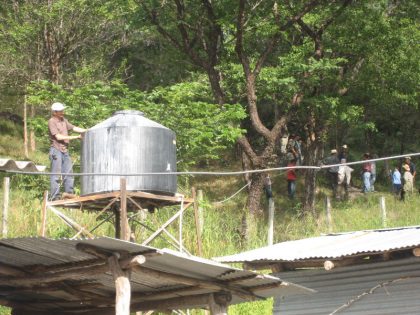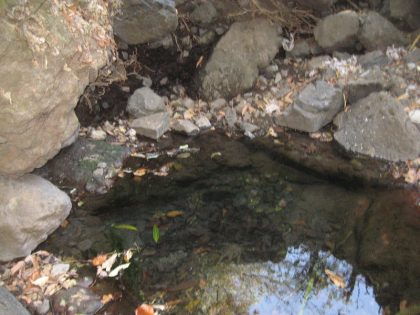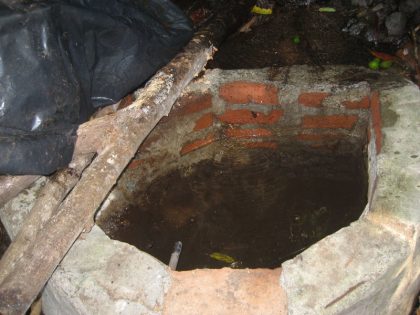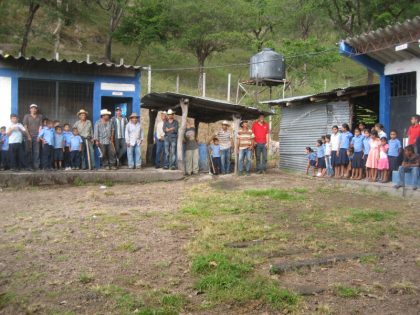 Location
Location
Caserio La Joya, Canton Las Marias, Municipio Nueva Esparta, Departamento La Uniòn, El Salvador
Community Description
La Joya is a small farming community in Canton Las Marias, in the municipality of Nueva Esparta, at the top of one of the tallest mountains in the northeast part of the country.
Nearly all of the people do agricultural work, farming mainly corn and beans. The vast majority of the farming done in the community is subsistence farming, which means that the people only grow enough to eat, but not enough to sell. The inhabitants live within an incredibly tight financial margin, often relying on the generosity of others and solidarity to make ends meet.
 Last year La Joya benefited from a rural electrification project that brought light to 90% of the houses in the area. Only 30% of the houses in La Joya have latrines. The other 70% of the houses are not equipped with even the most basic sanitary facilities.
Last year La Joya benefited from a rural electrification project that brought light to 90% of the houses in the area. Only 30% of the houses in La Joya have latrines. The other 70% of the houses are not equipped with even the most basic sanitary facilities.
Since no busses pass through the village, access to transportation is a major difficulty. Most people live more than 1.5 hours from the nearest bus route which limits access to commerce and health care.
The school is the central focus of the village, and one of its greatest uniting forces. Thanks to the creativity and dedication of the teachers over the last 12 years, the school has become a cultural center for the youth and a meeting place for the adults to discuss community events and projects.
 The school has 94 students from kindergarten to 6th grade. To receive education past 6th grade, some students choose to walk 90 minutes up the mountain to attend 8th and 9th grade. There are 3 classrooms and 3 teachers who come from the surrounding area to give classes every day.
The school has 94 students from kindergarten to 6th grade. To receive education past 6th grade, some students choose to walk 90 minutes up the mountain to attend 8th and 9th grade. There are 3 classrooms and 3 teachers who come from the surrounding area to give classes every day.
The school gets its water from an existing spring box, located 50 feet up the mountain. Water from the spring box flows into a storage tank that supplies the school with water for its daily needs. The tank currently sits on a base that is sagging, causing the tank to lose its structural integrity.
Insufficient water is being provided to the school, especially in the months of March and April. As a result, the students carry water from a nearby stream. During the rainy season, students walk 15 minutes to the stream to bring water, and during the dry season, the students walk 30 minutes in each direction to bring water. The water that they bring is less clean than the water from the spring.
 The spring box is a semi-circular cement wall built around the rock where the water comes out of the rock wall. The wall is built with a small hole at the bottom for a plastic tube that carries the water from the spring to the school. The spring box is located about 5 to 6 kilometers from the school. Because the spring is at a significantly higher altitude in relation to the school, no pump is needed. Gravity carries the water to the school.
The spring box is a semi-circular cement wall built around the rock where the water comes out of the rock wall. The wall is built with a small hole at the bottom for a plastic tube that carries the water from the spring to the school. The spring box is located about 5 to 6 kilometers from the school. Because the spring is at a significantly higher altitude in relation to the school, no pump is needed. Gravity carries the water to the school.
There is a long 1-inch diameter plastic tube that runs from the spring to the school. Until November of last year, the school had frequent shortages of water because cattle would step on the tube, breaking the seal and spilling water. In November the Parent Teacher Association organized 2 work days and the majority of the fathers in Las Joyas worked to bury the tube in the vulnerable areas. In areas where the tube crosses valleys, the tube is hung by barbed wire from trees.
The cement top for the spring box is meant to prevent leaves and garbage from clogging the tubes. Made of unreinforced cement, it is cracked and unserviceable.
There is one spigot below the water tank that is used to fill a stone wash bin where students wash the daily dishes. There are 4 spigots outside the bathrooms for hand washing. The tubing for the spigots runs from the tank, goes underground, and comes out through a wall near the bathroom.
The toilets flush with a bucket of water brought from the stone wash bin. The waste is flushed into an underground hole.
There is no piping in the classrooms or in the school office. Any water used in the school is brought from the stone wash bin, the spigot below the tank, or the bathroom spigots.
Project Description
This project is to provide an adequate water supply for the school during the entire year.
The spring where the school currently gets its water will be connected with a larger spring 50 meters up the mountain by running plastic tubing and providing a filter to prevent clogging.
A concrete platform will be built for the water tank, and the tank will be repaired. The cement top on the spring will be replaced by a new one, built of concrete and reinforced with a rebar. This will stop leaves and garbage from falling into the water, contaminating the water and clogging the tubes that carry it to the school.
The project is being implemented under the direction of the Asociación del Consejo Escolar (school advisory board).
Some of the fathers of school children work part-time as handymen or as construction workers when work is available. They have agreed to do all of the labor required to complete the project.
The mayor has agreed to provide transportation for the project supplies from the nearest city, Santa Rosa de Lima, located 2.5 hours away.
Project Impact
The project will benefit 127 people, including 94 students, 3 teachers, and 30 mothers who cook for the students.
Peace Corps Volunteer Directing Project
Jesse Flanagan
Comments
It is expected that the improvements to the water system will provide an uninterrupted flow of water for the school, and will last up to 15 years.
This is an extremely cost-effective project in that it provides long-lasting improvements at a very low cost. The project is well supported by the community and the school, and their commitment to provide the labor is essential to its success.
Dollar Amount of Project
$200.00
Donations Collected to Date
$200.00
Dollar Amount Needed
$0.00 – This project has now been fully funded through the generosity of The Soneva SLOW LIFE Trust as a part of their Clean Water Projects initiative.
We encourage others to continue to donate using the Donate button below, and we will notify Jesse of your donation. Additional funds will be used to fund the next project by the PCV and/or other projects in the country of service.
This project has been finished. To read about the conclusion of the project, CLICK HERE.